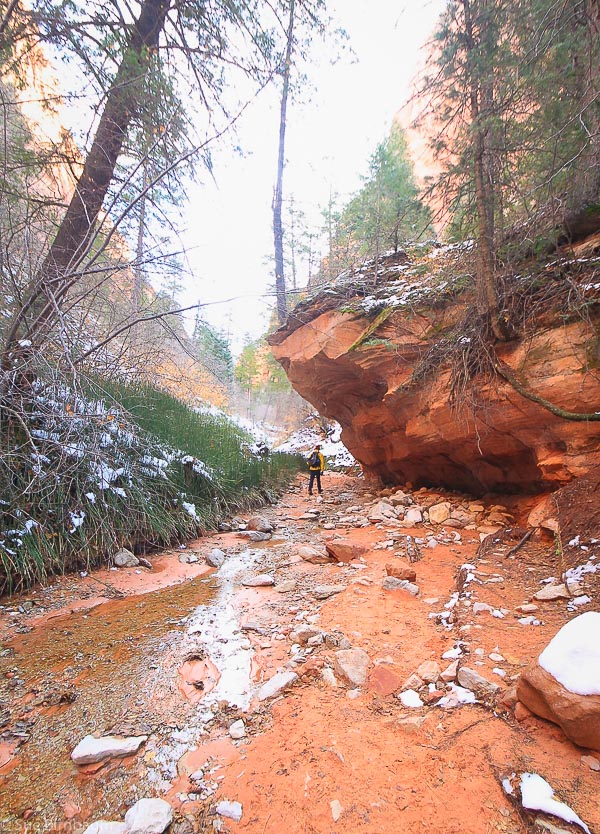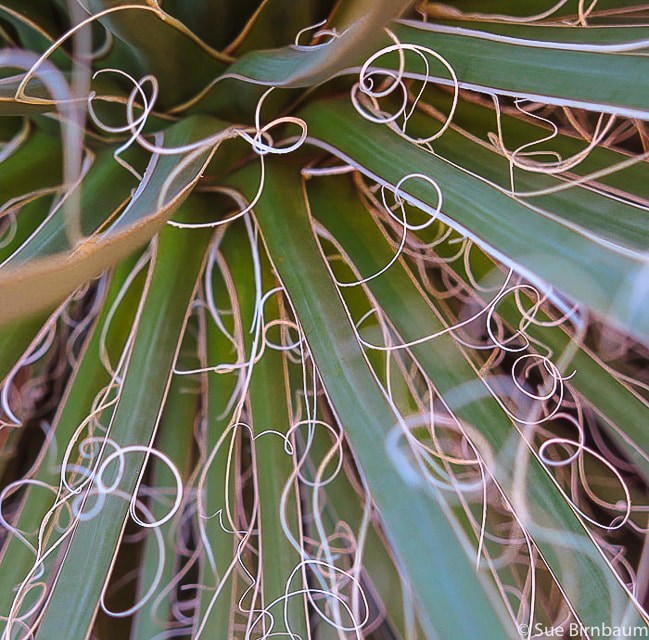|
This beautiful hike in the less-visited Kolob Canyons district of Zion National Park packs in a lot of geology, history and glowing sandstone colors for such a short hike. Related: Mt. Kinesava hike - Zion National Park Angels Landing in Zion: Not for the Faint of Heart Utah's Red Rock Country Desert Plant Photos Trip Stats: Location: Double Arch Alcove lies at the end of Middle Fork of Taylor Creek hike in the Kolob Canyons section of Zion National Park. This hike ends at the lower arch alcove; there is an arch above this, hence the name double arch alcove. Difficulty: easy - moderate class 1. Distance/Elevation Gain: 6.0 miles out and back, 500' elevation gain to double arch alcove. Trail head: 2 miles past the Kolob Canyons Visitor Center and Kolob Canyons Road within Zion National Park. Geology: Geologic features such as tilted and chevron-folded sediment layers and marine fossils in limestone can be seen on the way to double arch alcove. This trail traverses the Taylor Creek Thrust-Fault Zone and goes through 3 geologic formations as you climb. Some of the features are: Petrified Forest Member of the Chinle Formation, Moenave Formation (including the Kanarraville fold), Kayenta Formation and ending in Navajo Sandstone. History: 2 homestead cabins are located on this trail - both built in 1930. Best time to hike: Early morning light in this box canyon is beautiful due to sun reflections off towering Tucupit and Paria Points that reflect orange light. We like hiking this trail in the fall. Double Arch Alcove, Kolob Canyons, Zion National Park Navajo Sandstone of the Double Arch Alcove - Kolob Canyons - Zion National Park Taylor Creek Trail to Double Arch Alcove contains a treasure-trove of exposed geologic features in a relatively short distance. In the 450 feet of elevation from trailhead to alcove, the hike passes through three geologic formations. Like most box canyons, the hike starts at the lower, wider part of the canyon and climbs to narrower, higher walls on both sides. The towering wall seen from the north side of the canyon is Tucupit Point, and the wall seen from the south side is Paria Point. The hike ends at the alcove carved into Navajo Sandstone. Geology aside, you can enjoy the sheer beauty of this hike because of the creek's waterfalls, the pines and junipers, and the colors and patterns on the rock. The Larson homestead cabin, built in 1930, lies at the confluence of the Middle Fork and North Fork of Taylor Creek. The Fife homestead cabin is located further up the trail. Both are preserved well, and you can imagine what it might be like living through cold winter nights in this canyon. Early morning is the best time to hike along the Middle Fork of Taylor Creek to Double Arch Alcove because of the quality of the light. As the rising sun shines on towering red rock walls along the creek, it reflects an orange glow onto everything in the canyon. I feel like I'm enveloped in a soft light that relaxes me as I hike further. Everything is still, devoid of harsh shadows and colors are vibrant. The orange sand is soft underfoot and the creek crossings don't create an interruption in our stride. Small pond near creek where leaves were slowly circling together in a counter-clockwise direction Chevron fold seen in Middle Fork Taylor Creek in the Dinosaur Canyon member of the Moenave Formation - note chevron structure of folds due to compressional stresses placed on the rock During the Mesozoic Era, Western North America was in a mountain-building phase with compressional forces due to the Pacific Plate sliding underneath the North American Plate. The rocks of the Kolob Canyons were squeezed, compressed and uplifted. In the Middle Fork Taylor Creek Canyon, this resulted in the Taylor Creek Thrust-Fault Zone and the Kanarraville Fold. The photo above was taken on Thanksgiving 4 years ago when Fred and I first hiked this canyon. Gray limestone with bivalve fossils probably from the lower Carmel Formation Gustive Larson Cabin built in 1930 Early Morning in Late November Taylor Creek - Kolob Canyons Reflection from Tucupit Point into Middle Fork of Taylor Creek Middle Fork of Taylor Creek - Kolob Canyons - Zion National Park Double Arch Alcove Maidenhair fern on moist sandstone wall The scenery becomes more intense as you walk up the canyon. Then suddenly a wall of orange and red Navajo sandstone with black mineral stains looms above. The lower arch provides a wide alcove with water seeping from its walls. This is in fact what probably the impetus for the lower arch formation. Ground water seepage weakens and dissolves the cement between sandgrains, breaking down the sandstone. Blocks of sandstone then fall from the arch, accumulating below it only to be carried away by wind and water. The blind upper arch appears high above the lower arch. The whole scene is enveloped in a warm orange glow that is a reflection of light from the north canyon wall. The terrain is devoid of footfalls because of the soft orange sand. The green trees contrast with the orange and red. And to have some snow along the way as we did when we hiked this trail on Thanksgiving 2013 was an added bonus. Yucca in Snow Canyon State Park near St. George, Utah References:
Biek, R. F., Geologic Trail Guides to Zion National Park, Utah - Kolob Canyon Trails - Middle Fork of Taylor Creek Trail. Utah Geological Survey https://www.utahgeology.org/road_logs/uga-29_first_edition/NP_guide/ziontrai.pdf Website - "Watching for Rocks - Travels of a Sharp-eyed Geologist". Blog post April 21, 2011 http://www.watchingforrocks.com/2011/04/folding-and-faulting-in-kolob-canyons.html Website - "Zion National Park - Plate Tectonics" http://zion-gardner-bosch.weebly.com/plate-tectonics.html
3 Comments
7/6/2019 09:23:54 pm
The place is Instagram-worthy! If ever I will have time and my friends would go with me, I wimp make sure to see the beauty of Double Arch Alcove! Seeing the photos that you posted makes me want to go there as soon as possible. It seems like Zion National Park has a lot of beautiful sceneries to offer, and I couldn't be happier that I got the chance to see it. Most of the canyons I've seen were as great as this, but this one has better looks, that is one thing I am sure of!
Reply
7/12/2019 09:12:10 pm
Best Essay,
Reply
Leave a Reply. |
Categories
All
About this blogExploration documentaries – "explorumentaries" list trip stats and highlights of each hike or bike ride, often with some interesting history or geology. Years ago, I wrote these for friends and family to let them know what my husband, Fred and I were up to on weekends, and also to showcase the incredible land of the west.
To Subscribe to Explorumentary adventure blog and receive new posts by email:Happy Summer!
About the Author
|



















